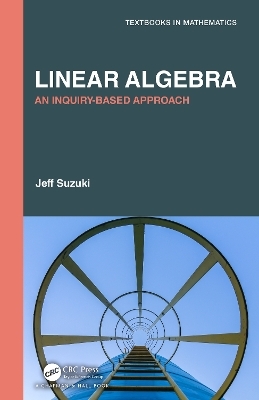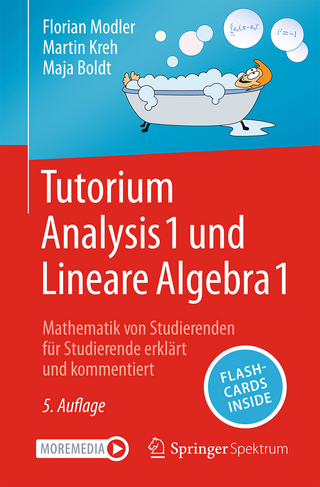
Linear Algebra
CRC Press (Verlag)
978-0-367-24896-3 (ISBN)
Linear Algebra: An Inquiry-based Approach is written to give instructors a tool to teach students to develop a mathematical concept from first principles. The Inquiry-based Approach is central to this development. The text is organized around and offers the standard topics expected in a first undergraduate course in linear algebra.
In our approach, students begin with a problem and develop the mathematics necessary to describe, solve, and generalize it. Thus students learn a vital skill for the 21st century: the ability to create a solution to a problem.
This text is offered to foster an environment that supports the creative process. The twin goals of this textbook are:
•Providing opportunities to be creative,
•Teaching “ways of thinking” that will make it easier for to be creative.
To motivate the development of the concepts and techniques of linear algebra, we include more than two hundred activities on a wide range of problems, from purely mathematical questions, through applications in biology, computer science, cryptography, and more.
Table of Contents
Introduction and Features
For the Student . . . and Teacher
Prerequisites
Suggested Sequences
1 Tuples and Vectors
2 Systems of Linear Equations
3 Transformations
4 Matrix Algebra
5 Vector Spaces
6 Determinants
7 Eigenvalues and Eigenvectors
8 Decomposition
9 Extras
Bibliography
Index
Bibliography
Jeff Suzuki is Associate Professor of Mathematics at Brooklyn College and holds a Ph.D. from Boston University. His research interests include mathematics education, history of mathematics, and the application of mathematics to society and technology. He is a two-time winner of the prestigious Carl B. Allendoerfer Award for expository writing. His publications have appeared in The College Mathematics Journals; Mathematics Magazine; Mathematics Teacher; and the American Mathematical Society's blog on teaching and learning mathematics. His YouTube channel (http://youtube.com/jeffsuzuki1) includes videos on mathematical subjects ranging
from elementary arithmetic to linear algebra, cryptography, and differential equations.
Jeff Suzuki is Associate Professor of Mathematics at Brooklyn College and holds a Ph.D. from Boston University. His research interests include mathematics education, history of mathematics, and the application of mathematics to society and technology. He is a two-time winner of the prestigious Carl B. Allendoerfer Award for expository writing. His publications have appeared in The College Mathematics Journals; Mathematics Magazine; Mathematics Teacher; and the American Mathematical Society's blog on teaching and learning mathematics. His YouTube channel (http://youtube.com/jeffsuzuki1) includes videos on mathematical subjects ranging from elementary arithmetic to linear algebra, cryptography, and differential equations.
Introduction and Features. For the Student . . . and Teacher. Prerequisites. Suggested Sequences. 1. Tuples and Vectors. 1.1. Tuples. 1.2. Vectors. 1.3. Proofs. 1.4. Directed Distances. 1.5. Magnitude. 1.6. Direction. 1.7. Unit and Orthogonal Vectors. 2. Systems of Linear Equations. 2.1. Standard Form. 2.2. Solving Systems. 2.3. Coefficient Matrices. 2.4. Free and Basic Variables. 2.5. Computational Considerations. 2.6. Applications of Linear Algebra. 3. Transformations. 3.1. Geometric Transformations. 3.2. Vector Transformations. 3.3. The Transformation Matrix. 3.4. Domain, Codomain, and Range. 3.5. Discrete Time Models. 3.6. Linear Transformations. 3.7. Transformation Arithmetic. 3.8. Cryptography. 4. Matrix Algebra. 4.1. Scalar Multiplication. 4.2. Matrix Addition. 4.3. Matrix Multiplication. 4.4. Elementary Matrices. 4.5. More Transformations. 4.6. Matrix Inverses. 4.7. Complex Matrices. 5. Vector Spaces. 5.1. Vector Spaces. 5.2. Kernels and Null Spaces. 5.3. Span. 5.4. Linear Independence and Dependence. 5.5. Change of Basis. 5.6. Orthogonal Bases. 5.7. Normed Vector Spaces. 5.8. Inner Product Spaces. 5.9. Applications. 5.10. Least Squares. 6. Determinants. 6.1. Linear Equations. 6.2. Transformations. 6.3. Inverse. 6.4. The Determinant. 6.5. A Formula for the Determinant. 6.6. The Determinant Formula. 6.7. More Properties of the Determinant. 6.8. More Computations of the Determinant. 6.9. Use(lesses) of the Determinant. 6.10. Uses of the Determinant. 6.11. Permutations. 7. Eigenvalues and Eigenvectors. 7.1. More Transformations. 7.2. The Eigenproblem. 7.3. Finding Eigenvalues: Numerical Methods. 7.4. Eigenvalues and Eigenvectors for a 2 x 2 Matrix. 7.5. The Characteristic Equation. 7.6. Stochastic Matrices. 7.7. A Determinant-Free Approach. 7.8. Generalized Eigenvalues. 7.9. Symmetric Matrices. 7.10. Graphs. 8. Decomposition. 8.1. LU-Decomposition. 8.2. QR-Decomposition. 8.3. Eigendecompositions. 8.4. Singular Value Decomposition. 9. Extras. 9.1. Properties of Polynomials. 9.2. Complex Numbers. 9.3. Mod-N Arithmetic. 9.4. Polar Coordinates. Bibliography. Index.
| Erscheinungsdatum | 05.05.2021 |
|---|---|
| Reihe/Serie | Textbooks in Mathematics |
| Zusatzinfo | 32 Line drawings, black and white; 32 Illustrations, black and white |
| Verlagsort | London |
| Sprache | englisch |
| Maße | 156 x 234 mm |
| Gewicht | 657 g |
| Themenwelt | Mathematik / Informatik ► Mathematik ► Algebra |
| Naturwissenschaften ► Physik / Astronomie | |
| Technik ► Umwelttechnik / Biotechnologie | |
| ISBN-10 | 0-367-24896-4 / 0367248964 |
| ISBN-13 | 978-0-367-24896-3 / 9780367248963 |
| Zustand | Neuware |
| Informationen gemäß Produktsicherheitsverordnung (GPSR) | |
| Haben Sie eine Frage zum Produkt? |
aus dem Bereich


